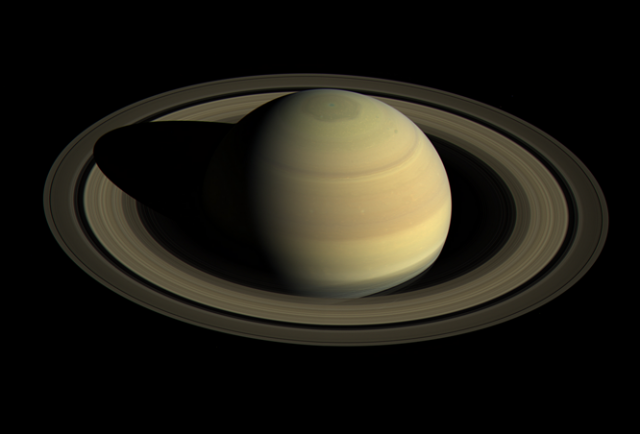Cassini Spacecraft ends its mission to Saturn with a bang
Five potential new missions to Saturn now being considered.

NASA scientists and fans of space science said their goodbyes to the Cassini spacecraft Friday, as it plunged into Saturn and concluded a successful 20-year mission to Earth’s spectacular sister planet.
…One of the last pieces of data captured by Cassini was an infrared image of the place into which it took its final plunge. The image, taken 15 hours before the spacecraft’s demise, reveals a spot on Saturn’s dark side just north of the planet’s equator where the spacecraft disintegrated shortly after losing contact with Earth.
Cassini was the first probe to orbit Saturn. Built and operated at JPL [Jet Propulsion Laboratory], it was launched in 1997 and inserted into orbit in 2004. The spacecraft revealed the structure of Saturn’s rings and, by delivering the Huygens probe to the moon Titan, executed the first landing of a spacecraft in the outer solar system. It also exposed two moons — Titan, a land of methane lakes, and Enceladus, which has jets of water streaming from its southern pole — as prime targets in the search for life beyond Earth.
Many scientists are already missing Cassini:
Peter Kollmann, 33, said he began the week excitedly anticipating Cassini’s final data. But as Friday drew near, his mood changed.
“I started being a scientist with Cassini,” said Kollman, who wrote his Ph.D. thesis on the spacecraft. He now works at the Johns Hopkins Applied Physics Laboratory in Laurel, Md., where his focus is a Cassini instrument that measures radiation belts.
“Knowing it will be over, it makes me sad,” he said. “But we’ll continue working with it because there’s still so much data.”
Carrie Nugent, 33, a self-described “asteroid hunter” and scientist at Caltech’s Infrared Processing and Analysis Center, worked on the spacecraft’s Composite Infrared Spectrometer while she was a graduate student at UCLA.
At 3:33 a.m., just after Cassini hurtled into the planet’s atmosphere but before JPL received its final signal, she said she was “wondering if it already died.”
“Personally, I’m pretty sad,” she said. “It’s a good little space robot, and I’ll miss it.”
However, these scientists and space exploration fans may be in luck. Because the Trump Administration’s priorities for NASA are geared more toward science than social justice, there are five proposed Saturn missions that are being considered.
NASA currently has no plans to return to Saturn, but that could change. In the latest round in a scientific competition called New Frontiers, NASA specified categories of missions it would consider. Those include a probe to study Saturn’s atmosphere or a mission to go to Titan or Enceladus, two moons known to have oceans.
The New Frontiers program solicits ideas for missions from teams of scientists and engineers. These projects can be ambitious, costing up to about $1 billion. Earlier proposals included Juno, now orbiting Jupiter, and Osiris-Rex, currently en route to the asteroid Bennu.
NASA may announce finalists by the end of the year. A winning mission is to be selected by summer 2019 for launch around 2025. At least five submitted proposals take aim at Saturn, Titan or Enceladus.
The following PBS series NOVA covers the Cassini mission:
There have been many astonishing discoveries made between all various space missions launched since I first began reading about the solar system five decades ago. Cassini, along with the Curiosity mission to Mars, have inspired an interest in physics and space science in my son. He and I would like to see long-term missions to each of our 9 planets (Yes, I still hold that Pluto is a planet).
Congratulations to everyone who made Cassini possible. This mission ended as brilliantly as it began.
 DONATE
DONATE
Donations tax deductible
to the full extent allowed by law.








Comments
What… no complaint from the Sierra Club for NASA trashing Saturn?
It was a great mission…. just wish the dive into Saturn could have had real time data like the Ranger probes of the moon. The telemetry would have been amazing.
The next mission should aim for a safe landing on Titan, with something akin to Mars Curiosity rover. Then it can be a two-fer. Study Saturn over the long term from close by and study one of the most interesting moons in the solar system as well.
Follow it up a few years later with a manned mission (okay – maybe quite a few years later) and it would be spectacular.
Will NASA simply ignore its core mission to improve Islamic self-esteem on science?
The smelly obama legacy.
Considering obama gave Iran the means to create nuclear weapons, he sure improved islamic self-esteem on science.
Michelle Obama 2020! (That’s just her weight.)
Will NASA simply ignore its core mission to improve Islamic self-esteem on science?
That mission is no longer needed, now that they’ve got Clock Boy to demonstrate their mastery of science.
I thought Clock Boy was a Texan?
“Governments on Saturn have issued stern protests over what they term as ‘an unwarranted attack on our planet from an alien race’.
“None of Saturn’s governments have stated what actions they might take in response to the incident, but anonymous sources tell Saturn News Network (SNN) any further incursions will result in the ‘strongest possible measures’ from Saturn’s vast fleet of hyper-capable starships.”
— SNN report filed 102/85/5712
NASA has put out a free ebook about Cassini:
“The Saturn System – Through the Eyes of Cassini”
https://www.nasa.gov/connect/ebooks/the-saturn-system.html
Downloadable in several formats.